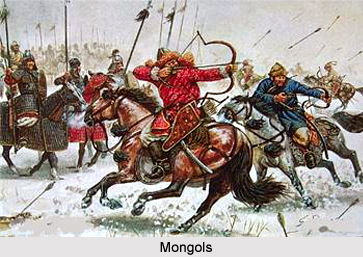 The Mongol also known as Mongolic people existed during the 13th and 14th centuries A.D. They belonged to the Central North Asian ethno linguistic group. They chiefly reigned over Eastern Europe, parts of Siberia, Middle East, Southeast Asia, the Iranian plateau and the Indian subcontinent. It is accounted that they ruled over almost 100 million.
The Mongol also known as Mongolic people existed during the 13th and 14th centuries A.D. They belonged to the Central North Asian ethno linguistic group. They chiefly reigned over Eastern Europe, parts of Siberia, Middle East, Southeast Asia, the Iranian plateau and the Indian subcontinent. It is accounted that they ruled over almost 100 million.
In 1260s a civil war erupted in the Mongol Empire. Chagatai Khanate, during that period took control over Central Asia. Duwa Khan since the 1280s led the Empire and actively ruled over Afghanistan. With a view to establish Mongal Empire in India Abdullah, the Negudari governor and the son of Chagatai Khan`s great grandson with a huge force attacked Punjab in 1292. The army under Ulghu was however, defeated and imprisoned along with its commander by the Khalji Sultan. The 4000 Mongol army incarcerated had to bear the brunt of the penalty imposed on them by the Sultan. They were all converted to Islam and were transported to Delhi renamed as `new Muslims.` They resided in a suburb named as Mughalpura. From 1296-1297 the Delhi Sultanate crushed the Chagatai tumens several times. After repeated attacks on Northern India the Mongols were finally able to gain control in their last two invasions.
In 1297 the two armies of the Mongols and Delhi Sultanate met at Jalandhar. In the first battle the Mongol army was defeated by Zafar Khan. However, the Mongols attacked again and annexed the Siri Fort. In another war that followed after the annexation, Zafar Khan, the then military commander crowned with the epithet of being the unbeatable, easily defeated the Mongol army and produced the 2000 prisoners before Ala-ud-din Khilji. In 1298 during a series of Mongol incursions a combined Turk-Mongol army waged a war on the Rajput Kings. A quarrel soon broke out over an argument about the division of captured riches between the Mongols and a Turk commander that resulted in the slaughter of Turk`s brother. These Mongol wives and children fled to the Rajput forts to escape from the atrocities meted out to them.
Soon Duwa Khan came into the picture with an aim to conclude the ongoing wars with the Yuan Khagan Temur Oljeytu. Peace was declared among the Mongol khanates in 1304 that brought to an end the quarrels and differences between the western khanates and the Yuan Dynasty that went for a long period of time. Thereafter, Duwa Khan planned for an invasion on India but the operation could not become successful.



















